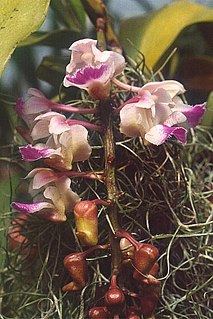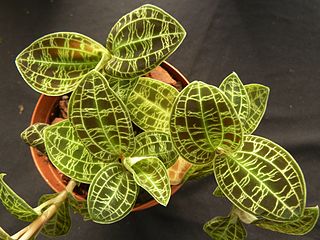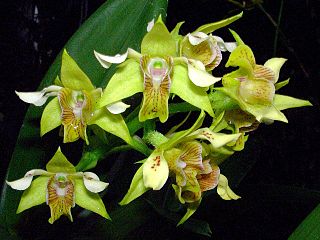
Dendrobium is a genus of mostly epiphytic and lithophytic orchids in the family Orchidaceae. It is a very large genus, containing more than 1,800 species that are found in diverse habitats throughout much of south, east and southeast Asia, including China, Japan, India, the Philippines, Indonesia, Australia, New Guinea, Vietnam and many of the islands of the Pacific. Orchids in this genus have roots that creep over the surface of trees or rocks, rarely having their roots in soil. Up to six leaves develop in a tuft at the tip of a shoot and from one to a large number of flowers are arranged along an unbranched flowering stem. Several attempts have been made to separate Dendrobium into smaller genera, but most have not been accepted by the World Checklist of Selected Plant Families.

Aerides, known commonly as cat's-tail orchids and fox brush orchids, is a genus belonging to the orchid family. It is a group of tropical epiphyte orchids that grow mainly in the warm lowlands of tropical Asia from India to southern China to New Guinea. They are valued in horticulture for their racemes of showy, fragrant, colorful flowers.

Cymbidium, commonly known as boat orchids, is a genus of evergreen flowering plants in the orchid family Orchidaceae. Orchids in this genus are epiphytic, lithophytic, terrestrial or rarely leafless saprophytic herbs usually with pseudobulbs. There are usually between three and twelve leaves arranged in two ranks on each pseudobulb or shoot and lasting for several years. From one to a large number of flowers are arranged on an unbranched flowering stem arising from the base of the pseudobulb. The sepals and petals are all free from and similar to each other. The labellum is significantly different from the other petals and the sepals and has three lobes. There are about fifty-five species and sixteen further natural hybrids occurring in the wild from tropical and subtropical Asia to Australia. Cymbidiums are well known in horticulture and many cultivars have been developed.

Grammatophyllum, sometimes abbreviated in horticultural trade as Gram, is a genus of 13 currently known orchid species. The name is derived from the Greek words 'gramma' and 'phyllon' (leaf), referring to the parallel leaf veins or the markings of the perianth. This epiphytic genus occurs in dense rainforest from Indo-China, to Indonesia, the Philippines, New Guinea, and the Southwest Pacific islands.

Dendrobium crumenatum, commonly called pigeon orchid, or 木石斛 is an epiphytic orchid in the family Orchidaceae and is native to Asia, Southeast Asia, New Guinea and Christmas Island. It has two rows on leaves along its pseudobulb and relatively large but short-lived, strongly scented white flowers. It usually grows in exposed positions in lowland rainforest and coastal scrub.

Macodes is one of a few genera of the orchid family known as jewel orchids. These terrestrial orchids grows in the rainforest floor of Southeast Asia with high humidity and low light. They can also be found in New Guinea, Vanuatu, the Solomon Islands and the Ryukyu Islands. The plant is cultivated for the veined leaves, unlike most other orchids that are valued for the flowers.

Pholidota, commonly known as rattlesnake orchids, is a genus of flowering plants from the orchid family, Orchidaceae. Plants in this genus are clump-forming epiphytes or lithophytes with pseudobulbs, each with a single large leaf and a large number of small, whitish flowers arranged in two ranks along a thin, wiry flowering stem that emerges from the top of the pseudobulb. There are about thirty five species native to areas from tropical and subtropical Asia to the southwestern Pacific.

Dendrobium bellatulum is a species of orchid. It is native to the eastern Himalayas and northern Indochina.

Dendrobium macrophyllum, commonly known as the large-leaved dendrobium or pastor's orchid, is a species of Orchid.

Dendrobium regium is a species of orchid endemic to India. It has been found in Chhattisgarh, Jharkhand, Orissa, and Andhra Pradesh.

Dendrobium sanguinolentum, the blood-stained dendrobium, is a species of flowering plant in the family Orchidaceae. It is native to Southeast Asia.

Dendrobium secundum, also known as the toothbrush orchid, is a species of flowering plant in the genus Dendrobium of the family Orchidaceae. The common name refers to the fact that all the flowers are on the same side of the stem, much like the bristles all on one side of a toothbrush.
Dilochia is a genus of flowering plants from the orchid family, Orchidaceae. It contains 8 known species, native to Southeast Asia and New Guinea.
- Dilochia beamaniiOrmerod - Borneo(Sabah)
- Dilochia cantleyi(Hook.f.) Ridl. - Indonesia, New Guinea
- Dilochia carnosaSulist. - Indonesia(Sumat ra)
- Dilochia celebica(Schltr.) Schltr. - Sulawesi
- Dilochia deleoniaeTandang & Galindon - Philippines
- Dilochia elmeriAmes - Philippines
- Dilochia longilabrisJ.J.Sm. - Sulawesi, Borneo
- Dilochia parvifloraJ.J.Sm. - Borneo
- Dilochia rigida(Ridl.) J.J.Wood - Sabah
- Dilochia subsessilis(Rolfe) S.Thomas - Myanmar
- Dilochia wallichiiLindl. - Thailand, Malaysia, Indonesia, New Guinea, Philippines
Poaephyllum is a genus of flowering plants from the orchid family, Orchidaceae native to Southeast Asia and New Guinea.
- Poaephyllum fimbriatumSchuit. & de Vogel - Papua New Guinea
- Poaephyllum grandiflorumQuisumb. - Palawan
- Poaephyllum pauciflorum(Hook.f.) Ridl. - Thailand, Malaysia, Borneo, Sumatra, Java, Philippines
- Poaephyllum podochiloides(Schltr.) Ridl. - Borneo, New Guinea
- Poaephyllum selebicumJ.J.Sm. - Sulawesi
- Poaephyllum tenuipes(Schltr.) Rolfe - New Guinea
- Poaephyllum trilobumJ.J.Sm. - New Guinea

Pteroceras is a genus of flowering plants from the orchid family, Orchidaceae. It is native to China, the Indian Subcontinent, and Southeast Asia.
"Blue Orchid" is a song by the White Stripes.

Dendrobium junceum is a species of the family Orchidaceae. The plant is native to Borneo and the Philippines.

Dendrobium uniflorum is a member of the family Orchidaceae. It is native to the Malesia and Southeast Asia regions, in Thailand, Vietnam, Malaysia, Philippines, Borneo, Sulawesi, Sumatra.

Dendrobium plicatile is an orchid species of Asia. It was formerly treated as Flickingeria fimbriata in the genus Flickingeria.

Dendrobium lobbii, commonly known as the straggly rush orchid, is a plant in the orchid family Orchidaceae and is native to an area extending from Indochina to northern Australia. It has thin, wiry stems with stiff leaves and mostly white or cream-coloured flowers singly or in pairs in leaf axils. Its white labellum does not open widely and sometimes remains closed.
















